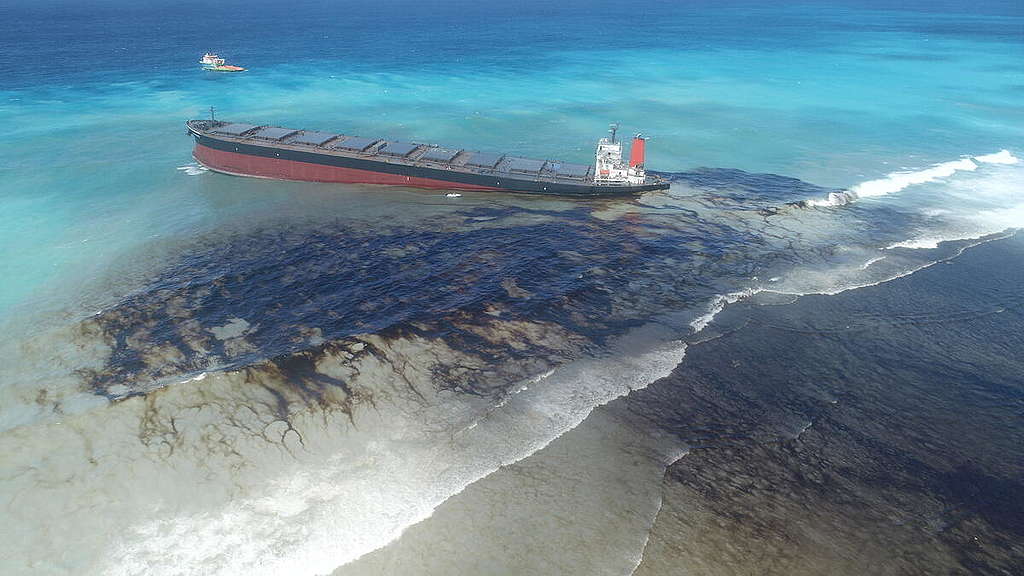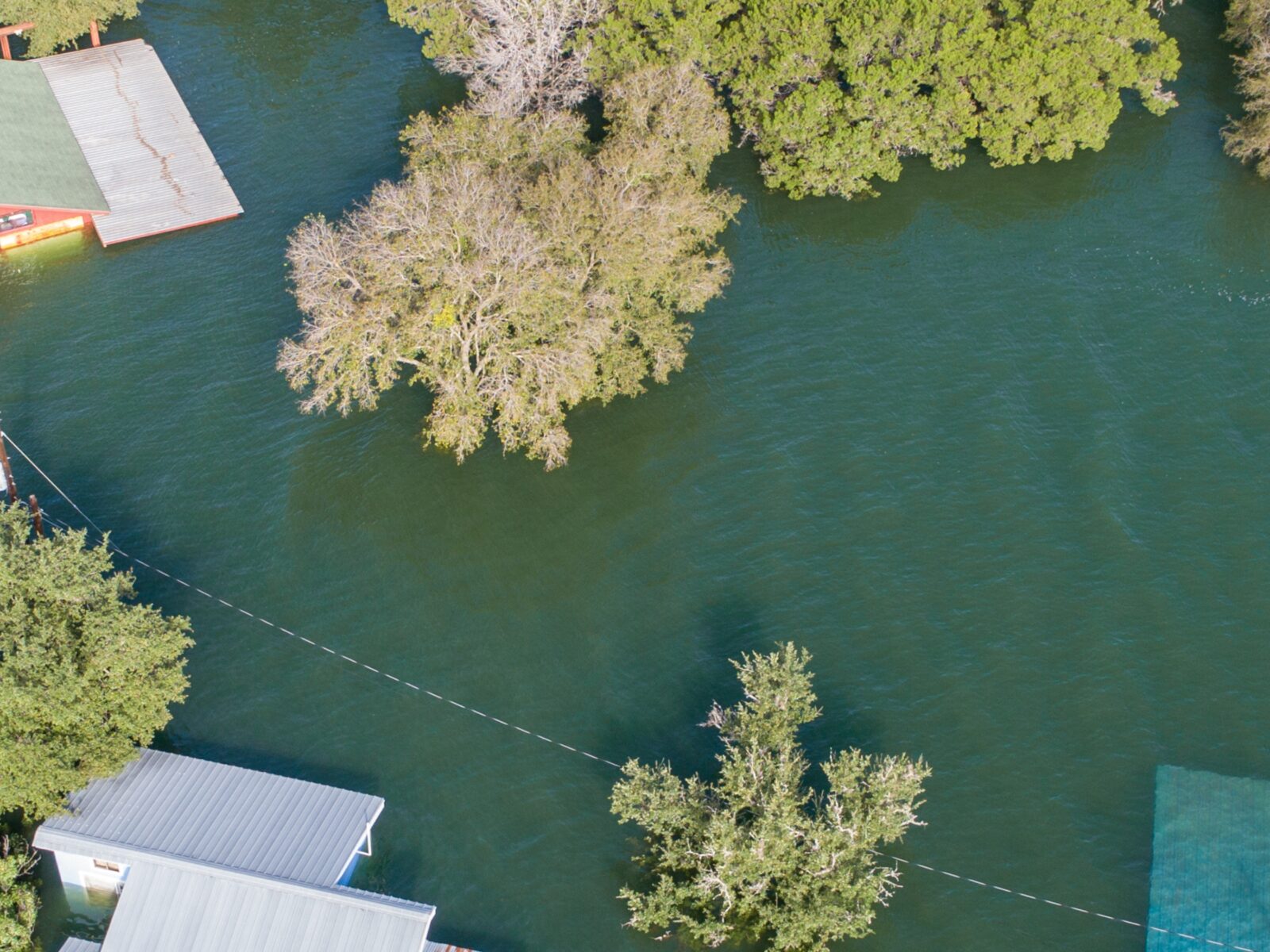Oil Spills and Climate Change 101
Victoria Whalen, ACE Fellow
|June 3, 2022

The scene of the oil spill in the waters around Mauritius after Japanese bulk carrier, MV Wakashio, ran aground on 25 July 2020. Greenpeace
Fossil fuels are a relic of the past that continues to cause exponential harm to our planet and our health. Today, the oil industry still makes up 40% of our global energy systems and is a major contributor to carbon dioxide emissions and global warming. As our environment becomes increasingly unstable, the process of oil extraction is becoming more harmful, with spills occurring everyday. How many more oil spill catastrophes must happen in order to stop fossil fuel corporate dominance?
The Process of Oil
Oil is a type of fossil fuel that is formed from the remains of prehistoric life. Oil can be found below ground on land, or below the ocean floor inside reservoirs. Inside these reservoirs are holes that contain oil droplets in the form of crude oil. Extraction of oil is often done by drilling down into the oil pockets and pumping the crude oil out through pipelines. Once extracted, the crude oil is shipped to a refinery where the oil is transformed into consumer products.
Examples of oil products include: gasoline, asphalt, plastics, soaps, and paints.
What are Oil Spills?
Like the name suggests, oil spills refer to any uncontrolled release of crude oil, gasoline, fuels, or other oil by-products into the environment. Typically these spills are often associated with water, but they can occur on land as well.
Below are the top five oil spills that have occurred worldwide:
- The Persian Gulf War Oil Spill (1991) is the biggest oil spill worldwide and released anywhere from 380 to 520 million gallons of oil into the gulf.
- BP Deepwater Horizon Oil Spill (Gulf of Mexico 2010) which released anywhere from 140 million gallons to 206 million gallons
- The Ixtoc 1 Oil Spill (Bay of Campeche 1979) released 140 million gallons of crude oil
- The Atlantic Empress Oil Spill (Trinidad & Tobago 1979) released 90 million gallons of oil
- The Mingbulak Oil Spill (Uzbekistan 1992) which released 88 million gallons

Impact of Oil Spills
Whether the spill is small or large, it’s impact is far-reaching and pollutes our air, land, and water systems. In the United States alone, there is an average of 1,000 oil spills every year. Spills are often caused by pipelines breaking, oil tanker ships sinking, or drilling & pumping malfunctions.
Wildlife & Ecosystems
The most immediate and noticeable consequence of spills are to the surrounding wildlife and ecosystems. Fouling (also known as oiling) is when oil physically harms a plant or animal. The more fouling occurs, the greater impact on the animal’s survival. Some examples include: oil coating bird feathers and wings, making them incapable of flight, or the oil stripping away the insulating properties on a sea otter fur, causing it to die of hypothermia. Whales, dolphins, and fish can ingest the oil, causing health defects as well as contamination that can be passed to humans when ingested. Long-term damage to ecosystems and habitats also occurs during a spill. Once oil washes up onto coastal marshes, mangrove forests, or other wetlands, it will be absorbed by the flora of the area and render the area uninhabitable.
Economy
Economic collapse is a major effect that occurs from oil spill pollution. Property values surrounding the oil spill area significantly decreased due to the length of the removal process. Local tourism becomes almost non-existent due to closing of beaches, parks, and other areas that have been contaminated. However, the largest economic loss is experienced by the local fishing industry and import-export trading. Unemployment rates skyrocket due to lack of aquatic life that is catchable and without fish, there can be no selling and trading. Fishermen, boatmen, and others in the industry go months without work, severely affecting their livelihoods and the livelihoods of those who rely on them for nourishment.
Oil and Climate Change
The oil industry is one of the major contributors to global warming and the ongoing climate crisis. The burning of oil releases carbon dioxide into our atmosphere and in 2013, gasoline made up 41 percent of the United State’s carbon dioxide emissions. Due to already fragile environmental conditions, the drilling and extraction of oil is getting harder to manage and contain, leading to more catastrophic spills.
However, most of the world is still reliant on oil, with about 40 percent providing global energy. Fossil fuel corporations are trying to keep this percentage to ensure their own profit. Many oil companies spend millions of dollars on lobbying and donating to political campaigns to make sure the global reliance on oil stays the same. Not only that, there are billions of dollars of subsidies for fossil fuel consumption which is more than five times the amount that renewable energy resources receive.
A California Oil Crisis
Thousands of oil spills occur in the United States every year and due to our reliance on fossil fuels and corporate greed, they are becoming even more frequent. On October 1st, 2021, the beaches of southern California were hit with one of the largest oil spills in California history. An estimated 126,000 gallons of heavy crude oil leaked into the waterways off of Orange County. The cause of the spill is suspected to be a leak in a 17.5 mile long underwater pipeline. Officials are estimating that the clean up process could keep the beaches closed for weeks and even months. With the southern California Coast being a hotspot for biodiversity as well as having a large wetland habitat, the effects of this spill could be devastating to both the environment and the economy of the area.
There are a few standard practices that are used to clean up oil spills. The first being booms. These are temporary barriers that are able to contain sections of oil in order to avoid leakage into surrounding areas. The current California crisis is being addressed using this method of containment to lessen the amount of oil into their wetlands. The second method are skimmers, which are devices that are used to glide across the surface area of the water and can skim the oil off. The last method is in-situ burning, which is a form of controlled burning to remove the surface level oil.

Want to learn more?
Want to read more? Check out the ACE Blog.
Join our Youth Action Network
More Blog Posts

From Pollution to Solutions: Chicago Teachers Union’s Push for Green Schools
Taking a bold stance for their students’ futures, Chicago teachers are advocating for climate solutions in their union contract, standing …
Read More
Vermont’s Climate Superfund
In a historic feat, Vermont created a new model to hold Big Oil accountable and force fossil fuel companies to …
Read More
Pulling the Plug on Not-so-Natural Gas
Have you ever heard the term “natural gas”? For decades, Big Oil has been trying to pull one over on …
Read More